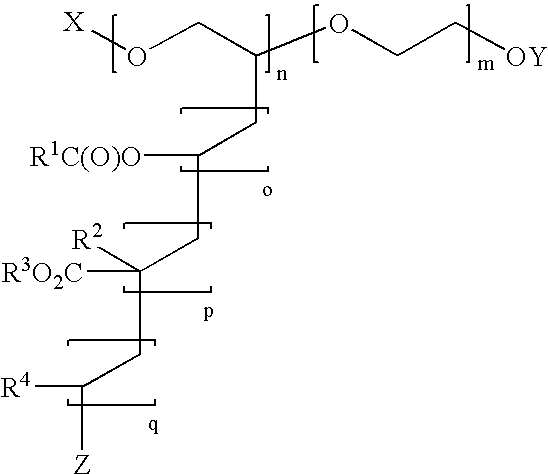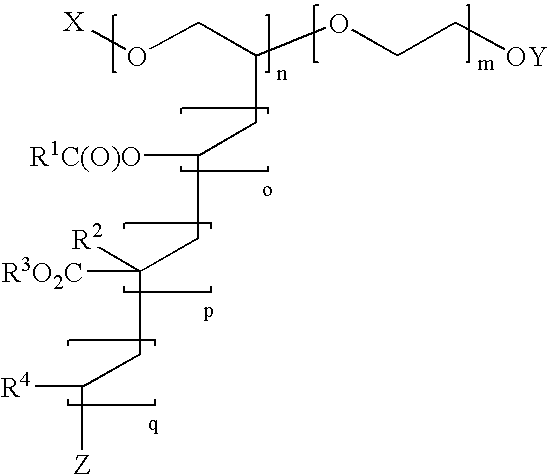Detergent composition
a technology of detergent composition and composition, applied in the field of laundry, can solve the problems that the formulating route including cationic surfactants still requires complex surfactant systems, and achieve the effects of reducing the viscosity of liquid components, improving the processing efficiency and cost efficiency of detergent compositions
- Summary
- Abstract
- Description
- Claims
- Application Information
AI Technical Summary
Benefits of technology
Problems solved by technology
Method used
Image
Examples
example 1
Spray Drying Process
[0059]The following detergent slurries were made by mixing the ingredients into water in the order listed to achieve solid contents in finished product as shown in the middle column. Then the slurry was sprayed into a tower where heated air (250-280° C.) is blown into at air flow rate 8000-9000 kg / h. The air flow and temperature were achieved to the target moisture content to be 5% in finished product. Powders were cooled down through the air lift and sieved over size (>2000 mm) before being stored in a silo. These powders were mixed with dry additives and sprayed perfumes to be finished product as shown in the left end column.
[0060]
Solids % inSolids % in finishedslurryproductIngredients(1)NaLAS17.017.0Dimethyle (Hydroxyethyl)0.20.2Ammonium ChlorideCleaning Polymer1.01.0Sodium silicate6.06.0Diethylene Triamine Penta0.40.4Acetic Sodium SaltPolyacrylic Acid1.01.0Carboxymethyl Cellulose0.20.2Brighteners0.20.2Phosphate16.016.0Sulfate33.033.0water12.05.0Misc.0.4Bleach...
example 2
Agglomeration Process
[0061]The following ingredients were fed into a high speed mixer to achieve the solid contents in finished product as shown in middle column while liquid ingredients (acid form of LAS and Dimethyle Ammmonium Chloride solution and polymer) were injected. The mixer speed was 700-800 rpm. After that, further agglomeration happens in second high shear mixer at 50-70 rpm. Agglomerates from second mixer were sent to a fluid bed dryer at 120 C via sieving over size (>2000 um) to evaporate some excess moisture. Then agglomerates were cooled in another fluid bed at 15 C before being stored in a silo. These agglomerates were mixed with dry additives and perfume spray-on to be finished product as shown in the left end column of the table below.
[0062]
Solids % inSolids % in finishedagglomerationproductIngredients(1)NaLAS14.0Dimethyle (Hydroxyethyl)0.20.2Ammonium ChlorideCleaning Polymer0.5-1.00.5-1.0Sodium carbonate25.025.0Phosphate15.015.0Zeolite2.02.0Water (from raw materi...
example 3
[0064]Bleaching high duty laundry detergent compositions are prepared.
[0065]
Ingredients(1)IIIIIIIVVVIVIIVIIIBlown PowderZeolite A13.6513.65——————Na Sulfate22.6722.6724.4330.13————LAS6.216.215.65—————QAS———2.95————MA / AA1.421.423.504.25————EDDS0.190.190.190.23————Brightener0.070.070.060.08————Mg Sulfate0.650.650.390.48————HEDMP0.170.170.170.21————Cleaning1.01.01.01.0PolymerAgglomerate 1QAS——0.9—————Carbonate——2.45—————Na Sulfate——2.45—————Agglomerate 2C14-15EO7——2.792.21————Na Sulfate——6.656.84————Agglomerate 3LAS————13.6314.96—13.63Cleaning————1.01.01.01.0PolymerZeolite A————21.4223.51—21.42Agglomerate 4LAS——————8.12—Na Sulfate——————23.54—Na Carbonate——————8.12—Dry additivesLAS——6.40—————MA / AA——0.890.890.950.950.990.95(particle)TAED3.583.583.802.705.895.896.14—NOBS———————5.50LAS (flakes)———27.0————Silicate R 2.03.853.853.852.80————Citric / Citrate3.583.583.583.583.803.803.963.80Na Carbonate7.727.7213.84—12.35—12.8712.35HEDP————0.480.480.500.48PC3 or PB111.0111.0111.018.008.558.558.918....
PUM
| Property | Measurement | Unit |
|---|---|---|
| wt % | aaaaa | aaaaa |
| weight % | aaaaa | aaaaa |
| wt % | aaaaa | aaaaa |
Abstract
Description
Claims
Application Information
 Login to View More
Login to View More - R&D
- Intellectual Property
- Life Sciences
- Materials
- Tech Scout
- Unparalleled Data Quality
- Higher Quality Content
- 60% Fewer Hallucinations
Browse by: Latest US Patents, China's latest patents, Technical Efficacy Thesaurus, Application Domain, Technology Topic, Popular Technical Reports.
© 2025 PatSnap. All rights reserved.Legal|Privacy policy|Modern Slavery Act Transparency Statement|Sitemap|About US| Contact US: help@patsnap.com


